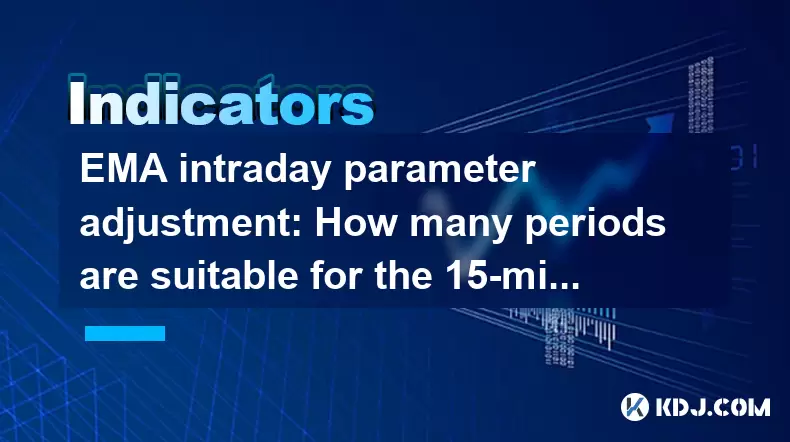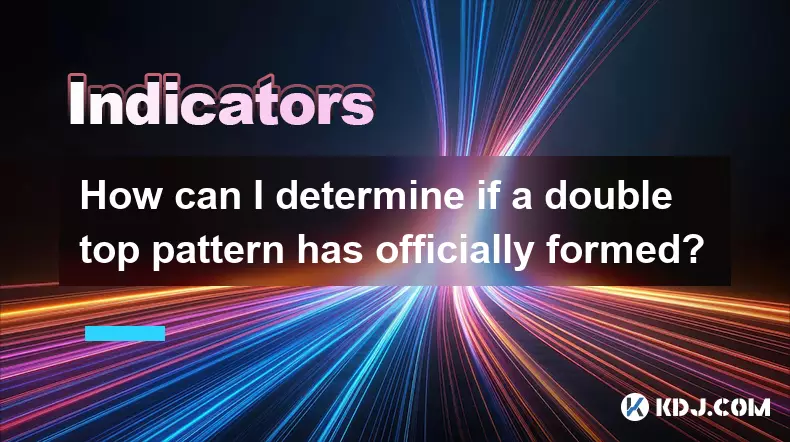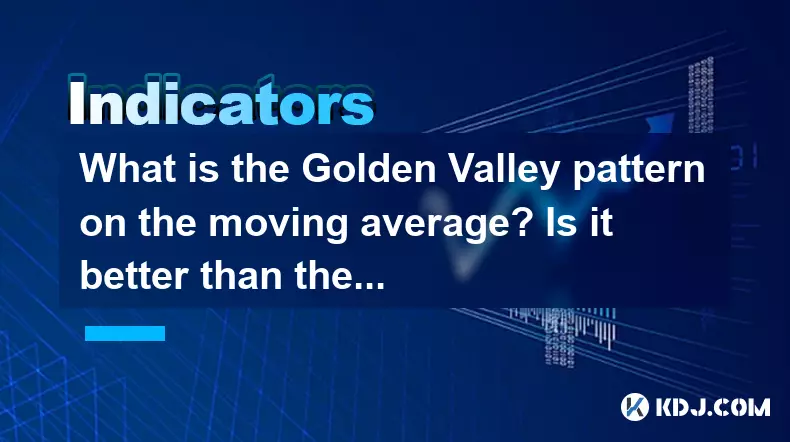-
 bitcoin
bitcoin $120167.907534 USD
1.27% -
 ethereum
ethereum $4468.611945 USD
2.53% -
 xrp
xrp $3.013607 USD
1.80% -
 tether
tether $1.000549 USD
-0.01% -
 bnb
bnb $1092.592149 USD
6.28% -
 solana
solana $231.391244 USD
4.59% -
 usd-coin
usd-coin $0.999699 USD
-0.04% -
 dogecoin
dogecoin $0.259020 USD
4.30% -
 tron
tron $0.342747 USD
0.34% -
 cardano
cardano $0.860977 USD
1.07% -
 hyperliquid
hyperliquid $50.155412 USD
5.34% -
 chainlink
chainlink $22.637678 USD
0.46% -
 ethena-usde
ethena-usde $1.000528 USD
-0.07% -
 avalanche
avalanche $30.613779 USD
-0.07% -
 stellar
stellar $0.403905 USD
0.94%
EMA intraday parameter adjustment: How many periods are suitable for the 15-minute chart?
EMA on 15-minute charts helps intraday traders; adjust periods like 9, 20, or 50 based on style and volatility for optimal trading signals.
May 21, 2025 at 04:21 pm

Introduction to EMA and Its Importance in Trading
The Exponential Moving Average (EMA) is a popular technical indicator used by traders to gauge the direction of a security's price movement. Unlike the Simple Moving Average (SMA), the EMA places more weight on recent prices, making it more responsive to new information. This characteristic makes the EMA particularly useful for short-term trading strategies, such as intraday trading. In this article, we will focus on adjusting the EMA parameters specifically for a 15-minute chart, a common timeframe used by intraday traders.
Understanding the 15-Minute Chart
The 15-minute chart is a favored timeframe for intraday traders because it provides a good balance between capturing short-term price movements and filtering out excessive noise. On this chart, each candle represents 15 minutes of trading activity, allowing traders to observe trends and patterns over several hours within a single trading day. The choice of the EMA period on a 15-minute chart is crucial as it directly impacts the sensitivity of the indicator to price changes.
Factors to Consider When Adjusting EMA Periods
When adjusting the EMA periods for a 15-minute chart, several factors need to be considered. The primary considerations include:
- Trading Style: Whether you are a scalper, day trader, or swing trader, your trading style will influence the optimal EMA period. Scalpers may prefer shorter periods to capture quick price movements, while day traders might opt for slightly longer periods to identify more sustained trends.
- Market Volatility: Highly volatile markets may require shorter EMA periods to react quickly to price changes, while less volatile markets might benefit from longer periods to smooth out fluctuations.
- Asset Class: Different assets, such as stocks, forex, or cryptocurrencies, can exhibit varying levels of volatility and liquidity, which may affect the optimal EMA period.
Common EMA Periods for 15-Minute Charts
For a 15-minute chart, several EMA periods are commonly used by traders. Here are some popular choices and their applications:
- 9-Period EMA: This is often used by scalpers and short-term traders looking to capture quick price movements. The 9-period EMA is highly responsive and can help identify rapid trend changes.
- 20-Period EMA: This is a middle ground that many day traders use. It provides a balance between responsiveness and smoothing out short-term fluctuations, making it suitable for identifying intraday trends.
- 50-Period EMA: This longer period is often used by traders who want to focus on more sustained trends within the day. It can help filter out noise and provide a clearer picture of the market direction.
How to Adjust EMA Periods on a 15-Minute Chart
Adjusting the EMA periods on a 15-minute chart can be done easily on most trading platforms. Here is a step-by-step guide using a typical trading platform:
- Open the Chart: Navigate to the trading platform and select the asset you wish to analyze. Open the 15-minute chart for that asset.
- Add EMA Indicator: Look for the indicator menu and select the EMA. You might find it under 'Moving Averages' or 'Technical Indicators.'
- Set the Period: Once the EMA indicator is added to the chart, you can adjust the period. For example, if you want to use a 20-period EMA, enter '20' in the period field.
- Customize Settings: Some platforms allow you to customize the color and style of the EMA line. Adjust these settings to your preference for better visibility.
- Analyze the Chart: With the EMA set, observe how it interacts with the price action on the 15-minute chart. Adjust the period if necessary to better suit your trading strategy.
Practical Examples of Using Different EMA Periods
To illustrate how different EMA periods can be used on a 15-minute chart, let's look at a few practical examples:
- Scalping with a 9-Period EMA: A scalper might use a 9-period EMA to quickly enter and exit trades based on short-term price movements. For example, if the price crosses above the 9-period EMA, it could signal a potential buy opportunity, and a cross below might indicate a sell signal.
- Day Trading with a 20-Period EMA: A day trader might use a 20-period EMA to identify intraday trends. If the price consistently stays above the 20-period EMA, it could indicate a bullish trend, and staying below might suggest a bearish trend.
- Swing Trading with a 50-Period EMA: A swing trader might use a 50-period EMA to capture more sustained trends within the day. If the price moves above the 50-period EMA and stays there, it could signal a strong bullish trend, while a move below might indicate a bearish trend.
Combining EMA with Other Indicators
While the EMA can be a powerful tool on its own, combining it with other indicators can enhance its effectiveness. Here are some common combinations:
- EMA and RSI: The Relative Strength Index (RSI) can help confirm EMA signals. For example, if the price crosses above the EMA and the RSI is above 50, it could strengthen the bullish signal.
- EMA and MACD: The Moving Average Convergence Divergence (MACD) can provide additional trend confirmation. If the MACD line crosses above the signal line while the price is above the EMA, it could reinforce a bullish trend.
- EMA and Bollinger Bands: Bollinger Bands can help identify volatility and potential reversal points. If the price moves outside the Bollinger Bands while the EMA confirms the trend, it could signal a potential entry or exit point.
Testing and Optimizing EMA Periods
Finding the optimal EMA period for a 15-minute chart often involves testing different periods and observing their performance over time. Here are some tips for testing and optimizing EMA periods:
- Backtesting: Use historical data to backtest different EMA periods. This can help you see how well each period would have performed in the past.
- Forward Testing: Apply different EMA periods to live market data in real-time to see how they perform in current market conditions.
- Adjust Based on Performance: Continuously monitor the performance of your chosen EMA period and be willing to adjust it based on changing market conditions or trading results.
Frequently Asked Questions
Q: Can the EMA period be adjusted dynamically during the trading day?A: Yes, some traders dynamically adjust the EMA period based on real-time market conditions. For example, if the market becomes more volatile, a trader might switch to a shorter EMA period to capture quick price movements. However, this approach requires careful monitoring and can be more complex than using a fixed period.
Q: How does the choice of EMA period affect the risk and reward of trades?A: The choice of EMA period can significantly impact the risk and reward of trades. Shorter EMA periods, such as a 9-period EMA, can lead to more frequent trading signals, potentially increasing both the number of trades and the associated risk. Longer periods, like a 50-period EMA, may result in fewer but potentially more reliable signals, possibly leading to higher rewards but also longer holding periods.
Q: Are there any specific EMA periods that work better for cryptocurrencies compared to other asset classes?A: Cryptocurrencies are known for their high volatility, which can make shorter EMA periods, such as 9 or 20 periods, more suitable for capturing rapid price movements. However, the optimal EMA period can still vary depending on the specific cryptocurrency and market conditions. It's essential to test different periods and find what works best for the particular asset you are trading.
Q: How can I use multiple EMA periods on a 15-minute chart to improve my trading strategy?A: Using multiple EMA periods, such as a combination of 9, 20, and 50 periods, can help create a more robust trading strategy. For example, a crossover of the 9-period EMA above the 20-period EMA could signal a short-term bullish trend, while the price staying above the 50-period EMA might confirm a longer-term bullish trend. This multi-EMA approach can provide different levels of confirmation and help filter out false signals.
Disclaimer:info@kdj.com
The information provided is not trading advice. kdj.com does not assume any responsibility for any investments made based on the information provided in this article. Cryptocurrencies are highly volatile and it is highly recommended that you invest with caution after thorough research!
If you believe that the content used on this website infringes your copyright, please contact us immediately (info@kdj.com) and we will delete it promptly.
- BlockDAG, DOGE, HYPE Sponsorship: Crypto Trends Shaping 2025
- 2025-10-01 00:25:13
- Deutsche Börse and Circle: A StableCoin Adoption Powerhouse in Europe
- 2025-10-01 00:25:13
- BlockDAG's Presale Buzz: Is It the Crypto to Watch in October 2025?
- 2025-10-01 00:30:13
- Bitcoin, Crypto, and IQ: When Genius Meets Digital Gold?
- 2025-10-01 00:30:13
- Stablecoins, American Innovation, and Wallet Tokens: The Next Frontier
- 2025-10-01 00:35:12
- NBU, Coins, and Crypto in Ukraine: A New Yorker's Take
- 2025-10-01 00:45:14
Related knowledge

What is a tower bottom candlestick pattern? Does it have a high success rate?
Sep 22,2025 at 07:18am
Tower Bottom Candlestick Pattern Explained1. The tower bottom candlestick pattern is a reversal formation that typically appears at the end of a downt...

What is a black hole pattern in the MACD indicator? Is it a cause for concern?
Sep 21,2025 at 06:54pm
Bitcoin's Role in Decentralized Finance1. Bitcoin remains the cornerstone of decentralized finance, serving as a benchmark for value and security acro...

How can I use the psychological line (PSY) to determine market sentiment?
Sep 17,2025 at 02:19pm
Understanding the Psychological Line (PSY) in Cryptocurrency TradingThe Psychological Line, commonly referred to as PSY, is a momentum oscillator used...

How can I determine if a double top pattern has officially formed?
Sep 21,2025 at 03:18am
Understanding the Structure of a Double Top Pattern1. A double top pattern consists of two distinct peaks that reach approximately the same price leve...

What is the Golden Valley pattern on the moving average? Is it better than the Silver Valley pattern?
Sep 21,2025 at 02:54pm
Understanding the Golden Valley Pattern in Moving Averages1. The Golden Valley pattern is a technical formation observed in cryptocurrency price chart...

What does a death cross of the RSI in the strong zone (above 50) mean?
Sep 17,2025 at 10:54pm
Understanding the Death Cross in RSI Context1. The term 'death cross' is traditionally associated with moving averages, where a short-term average cro...

What is a tower bottom candlestick pattern? Does it have a high success rate?
Sep 22,2025 at 07:18am
Tower Bottom Candlestick Pattern Explained1. The tower bottom candlestick pattern is a reversal formation that typically appears at the end of a downt...

What is a black hole pattern in the MACD indicator? Is it a cause for concern?
Sep 21,2025 at 06:54pm
Bitcoin's Role in Decentralized Finance1. Bitcoin remains the cornerstone of decentralized finance, serving as a benchmark for value and security acro...

How can I use the psychological line (PSY) to determine market sentiment?
Sep 17,2025 at 02:19pm
Understanding the Psychological Line (PSY) in Cryptocurrency TradingThe Psychological Line, commonly referred to as PSY, is a momentum oscillator used...

How can I determine if a double top pattern has officially formed?
Sep 21,2025 at 03:18am
Understanding the Structure of a Double Top Pattern1. A double top pattern consists of two distinct peaks that reach approximately the same price leve...

What is the Golden Valley pattern on the moving average? Is it better than the Silver Valley pattern?
Sep 21,2025 at 02:54pm
Understanding the Golden Valley Pattern in Moving Averages1. The Golden Valley pattern is a technical formation observed in cryptocurrency price chart...

What does a death cross of the RSI in the strong zone (above 50) mean?
Sep 17,2025 at 10:54pm
Understanding the Death Cross in RSI Context1. The term 'death cross' is traditionally associated with moving averages, where a short-term average cro...
See all articles










































































